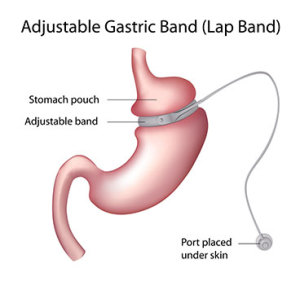
Lap banding (gastric banding) is the least invasive surgical procedure for a weight loss program.
It is performed laparoscopically (keyhole) where a soft silicone band is placed around the top part of the stomach to create a small upper pocket which restricts the amount of food a person can consume at a time.
The band is filled with saline, and is tightened or loosened to modify the size of the food passage.
Obesity is a great concern today. We have a greater awareness of its ill effect on health than ever before.Obesity is defined as having a body mass index above 30 kg/m2 (BMI>30). While modification of lifestyle remains the keystone for the treatment of obesity, surgical choices are on the increase. One of the surgical managements for obesity is the lap band or the gastric band procedure. This is only performed after exercise, diet and other ways fail to reduce the person’s weight.
Indications for Surgery
The following are the indications for lap banding:
- Body mass index of greater than 35 (or 30 in some cases)
- Failure of medical therapies to lose weight
- Obesity since childhood
- Presentation of diseases that may improve with weight loss
- Obesity related health problems
Contraindication To Lap Band Surgery
Lab banding is generally not recommended for individuals having any of the following complaints:
- Endocrine disorders such as hypothyroidism, which is not treated
- Certain inflammatory diseases of the gut: oesophagitis, peptic ulcers or Crohn’s disease
- If the procedure could put a patient at unreasonable risk
- Serious cardiopulmonary diseases
- A possibility of developing an allergic reaction from the material used in the band
- Patients who are drug or alcohol abusers
- People with cognitive disabilities or those who are emotionally unsteady
Steps Taken Before Surgery
The following tests are normally required before surgery can take place:
- Complete physical examination of a patient
- Blood tests
- Psychological evaluation to check whether the patient is mentally stable.
- Ultrasound of the gall bladder
- Nutritional status and counselling
- Advice from the doctor in the case of a person suffering from diseases such as diabetes, lungs or cardiac diseases, hypertension, etc.
Surgery is performed under general anaesthesia. 2-5 small incisions of 2 to 5 are made in the abdomen. Through these incisions a surgeon inserts a minute camera, known as laparoscope, which lets the surgeon visualize the inside of the abdomen. Also, via these incisions carbon dioxide is pumped into the abdomen. This will create a space so that a surgeon can perform the surgery with ease. A band is then placed around the upper section of the stomach. This helps to separate the upper part of the stomach from its lower part. A small pouch is formed this way, which possesses a narrow opening into the larger part of the stomach. Keep in mind this surgery does not require the opening of the abdomen. Only small incisions are made, therefore enable healing earlier.
The procedure takes an experienced surgeon less than 1 hour.
Records show that those undergoing this procedure can successfully reduce weight. However, the procedure should be complimented with an exercise and diet plan as suggested by the doctor. A patient may go home one day after the procedure and will stay on light or liquid food diet for a couple of weeks.
Risks & Complications
Risks in this procedure are related to anaesthesia, surgery itself and the band used to reduce the size of a stomach.
Anaesthesia related risks include
- Hazards related to respiration
- Allergic reactions due to drugs used for anaesthesia
Risks related to surgery include
- Intolerable pan
- Bleeding
- Infection either at the site of a surgery or other disseminated infection
- Problems related to cardiovascular system.
- Deep venous thrombosis
- Injury to the nearby organs
Risks due to gastric banding are
- Erosion of the gastric band into the stomach, if this occurs, immediate removal is necessary.
- Conditions such as heartburn, gastritis or peptic ulcer may occur.
- Reduced appetite and poor nutrition
- Constriction formation within the stomach that may cause blockage
- When overeating more than the stomach band can afford, vomiting occurs.
Lap band surgery has a very tiny death rate, about 0.1%. But this procedure is associated with a frightening rate of complications. Complications of the lap band are similar to its risks and include pouch dilation, mechanical malfunctions, oesophageal dilatation, pain at the site of band, and bulging of the port via the skin. Gastroesophageal reflux disease (GERD) is also common after this procedure and is another one of the complications. Other includes changes in bowel function, risk of hernia, indigestion and gallstones formation.
Q. Will I experience pain after the procedure?
A. You are expected to have some pain or discomfort on the sites of incisions on the abdomen. Pain may likely to be felt at the site of band. Left shoulder tip pain is also reported. It usually resolves on its own after a few days.
Q.How much weight will I lose?
A. It varies person to person, but on average after this procedure a patient can lose 50 to 60% of their surplus weight.
Q. Will this band remain long-lasting?
A. The life of the band is very long. It can last long for more than 30 years.
Q. What happens if I become pregnant after this weight loss procedure?
A. There is no contraindication in becoming pregnant while having a band.
Q. Do I still need to take medicines after gastric banding surgery?
A. Medicines are usually recommended but depending on their size, they may require crushing.
Q. How long will I remain away from work?
A. Depending upon your job, it may take 1-2 weeks. If you work sitting in an office then you can rejoin your work within a week, but if your work is related to lifting etc, then you should avoid it till your surgery wounds heal.
